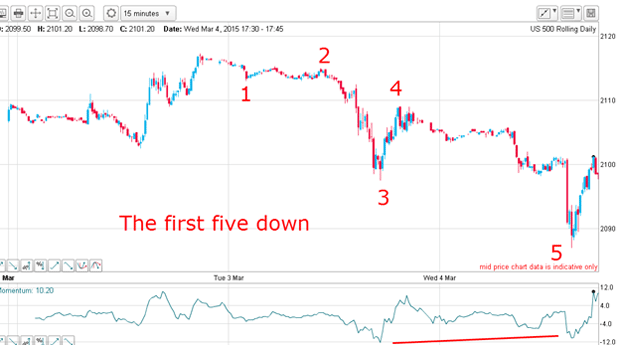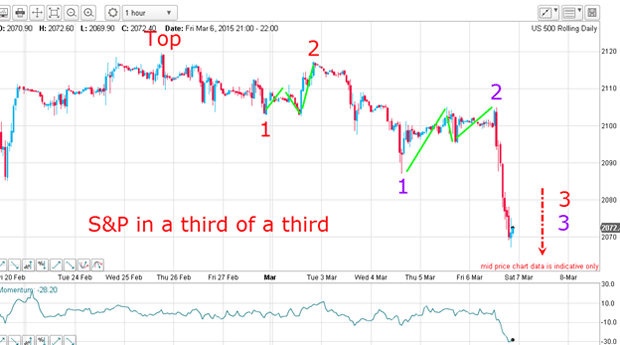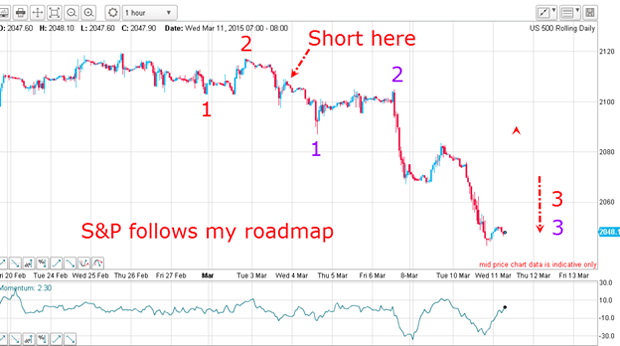My S&P trade keeps getting better
The sooner you can catch a major trend reversal, the more money you're going to make, says John C Burford.
On Monday, my posthad the tongue-in-cheek title, "How I made the perfect trade in the S&P".
That was a cheeky thing to say so early in the trade, but I had strong reasons to believe the trade would go well. Remember, I was proposing a short trade in a very long bull market.
Shorting into a rising market is normally regarded as trading suicide. In the Trading 101 course, the first lesson is: the trend is your friend.
MoneyWeek
Subscribe to MoneyWeek today and get your first six magazine issues absolutely FREE

Sign up to Money Morning
Don't miss the latest investment and personal finances news, market analysis, plus money-saving tips with our free twice-daily newsletter
Don't miss the latest investment and personal finances news, market analysis, plus money-saving tips with our free twice-daily newsletter
But trends eventually change, and when they do, your profits can rack up mighty quickly if you get in early; that's what makes a good trader. The earlier you can take a short position in a trend change, the bigger your profits. There is no value in getting into a new trend too late as it readies for a reversal.
Getting in early gives you another valuable advantage: the trade risk is at its lowest near the top. That may sound counter-intuitive, but as the market declines off the top, you run the greater risk of running into some large rallies which can easily stop you out of a promising position too soon.
Of course, my style of trading is slightly more aggressive than normal, and I understand some traders need to see more work on the downside before making a short commitment. Each to their own.
Naturally, no-one can be 100% certain that a particular trade will produce a profit. All we can do is examine the data and trade on probabilities. If the market follows your predictions, you'll gain confidence in them; that will allow you freedom to set price targets you can adjust in light of further price movements.
Let's look at my S&P trade to see how it works out in practice.
All the signs suggested a fall lo and behold

After that wave 5 low was in, I could say with some confidence that the trend had likely changed.Now, I needed to find a low-risk entry, which I did (see Monday's post).
On Monday, my Elliott wave roadmap was clear I had a series of 1-2s down. The market was then hard down in what I call a third of a third' wave.

This is one of the strongest patterns, and usually indicates that the market will head hard down, taking no prisoners.
Sure enough, markets have tanked since Monday. This is the situation this morning:

With my trade in good profit, I will be looking for a suitable point to take partial profits according to my split-bet strategy.
Complacency is bad for bulls, but good for shrewd traders
"It's OK, everyone was expecting this correction it's a healthy sign!"
"Hey this is just another dip to buy, so get buying!"
"The economy is fine GDP is going up, unemployment is going down, so what's the problem?"
"Stay calm, stocks are not expensive and the bull market is just getting going!"
"If the market falls a little further, the Fed will come to put out the fire again as they have since 2008."
These sentiments are typical of the advice dished out by the media when horror of horrors stocks actually decline a little.
They are uttered by bulls who have married their positions and are in no mood to get a divorce.
Attitudes like that start bear markets: before too long, though, manic levels of complacency (low Vix readings) and bullish sentiment around the top give way to a gradual realisation that panic should have started earlier.
Get the latest financial news, insights and expert analysis from our award-winning MoneyWeek team, to help you understand what really matters when it comes to your finances.
John is is a British-born lapsed PhD physicist, who previously worked for Nasa on the Mars exploration team. He is a former commodity trading advisor with the US Commodities Futures Trading Commission, and worked in a boutique futures house in California in the 1980s.
He was a partner in one of the first futures newsletter advisory services, based in Washington DC, specialising in pork bellies and currencies. John is primarily a chart-reading trader, having cut his trading teeth in the days before PCs.
As well as his work in the financial world, he has launched, run and sold several 'real' businesses producing 'real' products.
-
 Why Trustpilot is a stock to watch for e-commerce exposure
Why Trustpilot is a stock to watch for e-commerce exposureTrustpilot has built a defensible position in one of the most critical areas of the internet: the infrastructure of trust, says Jamie Ward
-
 Tetragon Financial: An investment trust with stellar returns
Tetragon Financial: An investment trust with stellar returnsTetragon Financial has performed very well, but it won't appeal to most investors – there are clear reasons for the huge discount, says Rupert Hargreaves